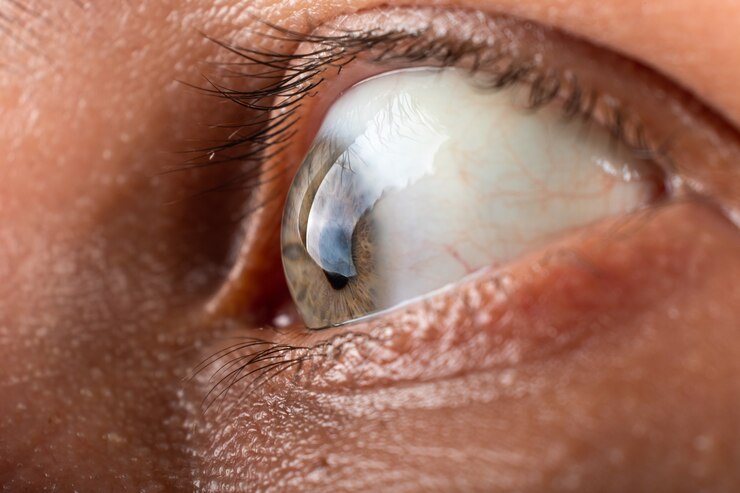Corneal blindness presents a significant health and economic challenge, particularly affecting younger populations who are generally more economically active. Unlike conditions such as cataracts, glaucoma, and age-related macular degeneration (AMD), corneal blindness primarily impacts younger individuals, especially those from rural and lower socio-economic backgrounds with limited access to healthcare services. In these populations, infections and trauma are the predominant causes, exacerbated by inadequate eye care access.
Table of Contents
What is the Cornea?
The cornea is the transparent, dome-shaped outermost layer of the eye. It covers the iris, which is the black part of the eye. Together with the eye’s natural lens, the cornea helps focus light rays onto the retina, the light-sensitive part of the eye. For the cornea to work properly, it must remain clear and free from irregularities. Scarring, which can result from infections, inflammation, trauma, or hereditary diseases, can cause significant vision loss and even lead to corneal blindness.
Understanding Corneal Blindness
Corneal blindness refers to significant vision loss or blindness caused by diseases of the cornea. It ranks as the fourth most common cause of blindness worldwide, accounting for over 5% of the total blind population. Other leading causes of blindness include cataracts, glaucoma, and AMD.
Causes of Corneal Blindness
- Infections and Ulcerations: Infections such as bacterial, fungal, or viral keratitis (corneal infection) are major causes. Trachoma, an eye infection, has blinded approximately 9 million people globally. Rare infections like onchocerciasis and leprosy have caused around 250,000 cases of blindness.
- Malnutrition: Vitamin A deficiency is a significant cause of childhood blindness, particularly among malnourished children.
- Trauma: Eye injuries and corneal ulcerations lead to about 2 million new cases of blindness each year.
- Congenital Diseases: Each year, around 350,000 children are affected by blindness due to congenital disorders or early-life corneal infections and ulcerations.
- Other Corneal Disorders: Conditions such as Fuch’s Endothelial Dystrophy and Pseudophakic Bullous Keratopathy, whether hereditary or acquired, also contribute to substantial vision loss.
- Lifestyle Issues: In countries like India, traditional remedies such as ayurvedic drops, kajal, and surma can damage the eyes, causing vision loss. Harmful practices like using honey as eye drops and ginger juice for eye cleansing, along with the misuse of steroid eye drops, further worsen the situation.
Preventive Measures for Corneal Blindness
Managing corneal blindness involves prevention, treatment, and rehabilitation.
- Provision of Clean Water: Trachoma, caused by Chlamydia trachomatis, leads to corneal blindness through lid distortions and increased infection risk. Poor facial and hand hygiene spread trachoma. The SAFE strategy (Surgery for trichiasis, Antibiotics for infection, Facial cleanliness, and Environmental improvement) helps control trachoma by improving water supply and promoting facial cleanliness.
- Addressing Xerophthalmia: Vitamin A deficiency, often worsened by measles, diarrhea, or other illnesses in malnourished children, causes xerophthalmia (eye dryness). Preventing vitamin A deficiency involves supplementation, measles vaccination, nutritional advice, and early diarrhea treatment.
- Combating Onchocerciasis (River Blindness): Onchocerciasis, caused by Onchocerca volvulus microfilaria, leads to severe eye inflammation and blindness. The Simulium fly transmits this infection. Control measures include promoting hygiene, controlling the Simulium fly, and mass distributing ivermectin, the definitive treatment for onchocerciasis.
- Preventing Trauma: Corneal injuries, common among farmers and children, can cause significant vision loss if not treated properly. Simple antibiotic eye drops can prevent corneal infections following trauma. However, rural India often lacks proper healthcare, relying on quacks and harmful indigenous treatments.
Definitive Treatment: Corneal Transplantation
The definitive treatment for corneal blindness is corneal transplantation or grafting. This surgery replaces part or all of the damaged cornea with a healthy one donated upon someone’s death. However, the number of donated corneas is far fewer than needed, with fresh cases adding to the transplant list.
Promoting Eye Donation and Awareness
To reduce corneal blindness, two key actions are necessary: promoting eye donation and transplantation and raising awareness about eye diseases and timely interventions. Increasing eye donation rates and improving education on eye health can significantly reduce the prevalence of corneal blindness.
By understanding corneal blindness and its causes, and taking preventive measures, we can work towards reducing its impact on individuals and communities.
